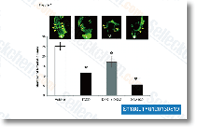Ubiquitin proteasome dependent proteolysis seems to perform a serious position in muscle protein degradation including enhanced proteoly sis following denervation. The E3 ubiquitin ligases muscle ring finger protein one and muscle atrophy F box appear to get crucial and their mRNA expression ranges raise in the amount of various atrophic problems like denervation. Increased Akt activity has become advised to reduce the expression of MuRF1 and MAFbx primarily based around the skill of Akt to phosphorylate Foxo transcription components. In atrophic denervated muscle, on the other hand, unchanged or enhanced Akt phosphorylation/activity suggests that other signaling mechanisms are of relevance for regulating the expression of MuRF1 and MAFbx in denervated muscle.
This kind of signaling mechanisms may possibly include things like tumor necrosis factor like weak inducer of apoptosis and its receptor, fibroblast development element inducible receptor 14, nuclear component kappaB, heat shock proteins this kind of as Hsp70 and Hsp25rodent/27human and mitogen activated protein kinase activated protein kinase two, a substrate of p38 MAPK. Conclusions selleckchem Rapamycin This examine has examined the hypothesis that Akt/mTOR signaling is increased in hypertrophic muscle and decreased in atrophic muscle employing a model consisting of different denervated skeletal muscles. The outcomes are constant with previous scientific studies displaying greater Akt/ mTOR signaling in models of hypertrophic skeletal muscle. In contrast to past scientific studies, on other designs of skeletal muscle atrophy, the current study discovered no evidence of decreased Akt phosphorylation in atrophic denervated anterior tibial muscle.
The results in the existing research also propose increased signaling by mTOR, indicating enhanced protein synthesis, in denervated atrophic muscle groups likewise as in denervated hypertrophic muscular tissues. Elevated protein degradation, AVL-292 ic50 rather than decreased protein synthesis, is consequently prone to be responsible for the reduction of muscle mass in dener vated atrophic muscular tissues. A lot of the alterations in protein expression and phosphorylation observed within the present research may very well be connected to denervation changes in skeletal muscle apart from those directly concerned from the regulation of muscle mass. Approaches Animals All experiments were performed on adult male NMRI mice. Before surgery the animals have been anaesthetized by inhalation of isoflurane or sevoflurane.
Denervation with the left hind limb or even the left hemidiaphragm was performed by sectioning and getting rid of a number of mm of your sciatic nerve or phrenic  nerve as described previously. While still anaesthetized animals acquired a subcutaneous injection of buprenorphine for analgesia. Six days just after denervation mice had been killed by cervical dislocation. The experimental manipulations happen to be approved through the Ethical Committee for Animal Experiments, Linkping, Sweden.
nerve as described previously. While still anaesthetized animals acquired a subcutaneous injection of buprenorphine for analgesia. Six days just after denervation mice had been killed by cervical dislocation. The experimental manipulations happen to be approved through the Ethical Committee for Animal Experiments, Linkping, Sweden.
Natural Products
The latest published issue of Journal of Natural Products
